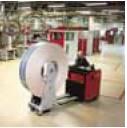 Network
Video Solution
Network
Video Solution
Market Segments
The
factors driving any market are usually associated with increasing
the opportunity to do things more quickly and efficiently, thus
saving both time and money. The case of network video is no different.
Changing
Attitudes
Where end-users are concerned, there has been a dramatic shift
in attitudes over the last decade. Once, the sight of a network
camera might have caused suspicion, being associated with authoritarian
political regimes and the corresponding curtailment of civil liberties.
By contrast, now that virtually all businesses, schools and industries
are connected to the Internet, there is an increasing acceptance
of network video as a normal observation tool. Images viewed over
the network are generally perceived as harmless, representing
part of a larger system, of which the majority already have a
good understanding. Since the technology furthermore enhances
public security and can even be entertaining, many now regard
it as positive.
Practical
Technology
For those using the technology directly, a number of practical
factors come into play. Images stored on hard disks make searching
and retrieval much faster and easier, and lead to minimal maintenance
costs. Computers and other functions such as facility management
and access control, are clearly converging toward a common IP
network that can offer integrated services. At the same time,
new innovative ways of using network video are being developed.
Gaining
Popularity
Network video is proving to be attractive in a vast array of market
segments. At times, it is replacing traditional-style systems
to reduce cost overheads, while in other areas it is being used
for the first time as more people come to understand how the technology
can meet their particular needs. An example of the former, would
be a surveillance system switching from CCTV to network video,
and an example of the latter would be remote monitoring of equipment
by service engineers.
 applications
in the following market segments:
applications
in the following market segments:







